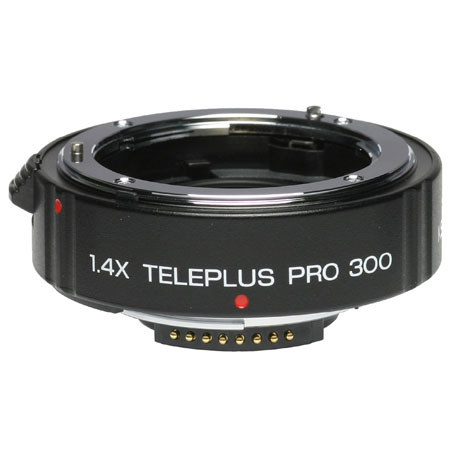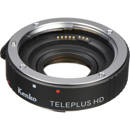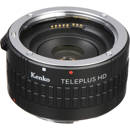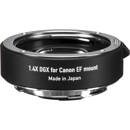
Kenko Teleplus PRO 300 DG AF 1.4x Teleconverter for Canon EOS
SKU: KN14XPDEOS
This item is no longer available.
Recommended Alternatives
Share:
Overview
Compare
Protection
Q&A
Questions & Answers
Reviews about this item
Review Summary
2009-10-22T21:00:00
Rated 5 out of 5
Awesome. Great Value. Can't miss
VERY sharp for a TX. My 50D will (sometimes) still autofocus at F6.3. My 28-135 IS with the TX is sharper than blowing up a subject. Works with my lens, whereas the Canon TX won't. EXCELLENT value. Add one to your bag!
Mermaid M.
2008-09-10T21:00:00
Rated 5 out of 5
Wonderful Product
After much research and comparison with the Canon 1.4x Teleconverter, I decided to buy this product. No regrets at all. It works on all my lenses including the EF70-200 f4L IS, EF24-105 f/4L IS, EF16-35L f2.8 MkII & EF50 f1.4. On the EF70-200 f4L IS, you get correct read outs on exposure but AF slows down. Understand that this will happen to maintain focus accuracy. The other lenses are technically not supported but the AF still works perfectly well. However the exposure reading will be wrong on the camera but you just have to compensate mentally by 1 stop. I am using a 1D MkIII and my EF50mm f1.4 becomes a 91mm f2 (Perfect Portrait Lens), the 16-35mm f2.8 to a 29-64mm f4 and my 24-105mm f4 to 44-191mm f5.6. Optically, I don't see much loss of quality. I must say that this is one of the best kept product secrets in the market.
Soo P.
2007-04-25T21:00:00
Rated 4 out of 5
Good bang for the buck
I bought this to use with both my 70-200f4L and 70-200f2.8L IS lens. It's pretty tight between the lens and this, and slightly looser between the body and TC. The images taken with the 70-200f2.8L lens comes out sharper than without the TC. I did toy around and try this on the 70-300DO and the 75-300 Canon lens, and it worked, but the camera might hunt a bit.
SCOTT C.
2007-02-12T19:00:00
Rated 5 out of 5
Exceeded expectations
Prior to making my purchase, I researched 10 product reviews and (what few) user reviews I could find on 1.4X, 2X and 3X teleconverters for the Canon EOS from the following manufactures: Canon, Kenko, Sigma and Tamron. I wanted something that would be compatible with the Canon EOS Rebel XTi body and the Canon AF EF 70-200mm f/4.0 "L" USM zoom telephoto lens. Canon's teleconverters seemed a bit pricey for my needs (I'm not a professional), and I didn't want to sacrifice additional f/stops, which would be the downside of the 2X and 3X teleconverters. I figured the loss of one f/stop was enough, especially since none of my lenses have IS. Kenko's Teleplus Pro 300 DG AF 1.4X Teleconverter works perfectly with the above camera/lens combination. From 70 to 200mm (and everything in-between) the AF, aperture and shutter controls operate as efficiently with the teleconverter as they do when the teleconveter is removed. Since all the specs are easily available, I won't repeat them in my review. I will say that the Kenko Pro 1.4X teleconverter has a nice, professional finish. The connection to the XTi camera body is clean, tight and solid; and it releases cleanly. Likewise, the tele-zoom lens that I intended to use with the teleconverter, connects and disconnects smoothly. The connection is solid and sure--no wobble or rattle. Although Kenko's product reviews do not recommend this teleconverter for use with a zoom under 100mm, I was pleasantly surprised to discover that this Kenko teleconverter worked flawlessly with two other lenses I have for the XTi body: Canon's 50mm f/1.4 USM (obviously not a zoom), and the Tamron AF 17-50mm f/2.8 (a wide angle zoom with focal lengths considerably below the recommended 100mm minimum). I shot 325 images testing Kenko's teleconverter with all 3 lenses--with and without a tripod, with and without a shutter release cable, with and without a flash (Canon's Speedlite 430EX). I used a SanDisk Extreme III 4GB CF card to store the images. I shot images at 100 and 800 ISO. I used the "L" quality (10.2 megapixels) setting for all the images. I shot half the images using the "Priority" setting, and half the images using the "Tv" setting, in order to compare aperture changes (yup, you do lose an f/stop with this converter). I shot single-shot and continuous bursts (including several at the maximum 27-shot continuous burst). The Kenko teleconverter worked flawlessly with all three lenses, and flawlessly along the entire zoom focal lengths of both zoom lenses. It was interesting to note that when I examined the images (considerably enlarged), the widest focal length on the Tamron wide angle zoom (17mm) had some purple fringing near the edges where tree branches were contrasted against the sky, Yet, the purple fringing was almost negligible with the image using the teleconverter. (It's possible this occurred because the wide angle 17mm was no longer 17mm--it became 24mm after the 1.4X increase. Additionally, Canon's APS-C size CMOS sensor will increase the overall effective focal length of any of Canon's EF lenses by an additional 1.6X. Consequently, a 70-200mm lens effectively becomes a 157mm-448mm for a standard 35mm camera.) Image quality: I have to assume that the addition of any teleconverter must degrade image quality somewhat due to the fact that there is additioinal glass for the image to pass through. However, I didn't notice a difference in quality. If there was, it was negligible since I couldn't see a difference. If I was making poster-size enlargements, I might see a difference...maybe. The bottom line: it worked perfectly with my Canon "L" series USM zoom-telephoto lens, the excellent Canon primary 50mm f/1.4 USM lens, and my carry-most-of-the-time Tamron 17-50mm wide angle zoom lens. Image quality remained excellent, and in fact, seemed to improve the image quality of the Tamron lens when it was opened up to 17mm. I can't address the Kenko teleconverter's longevity since I've only had it for several months. Plus, I don't know how it will respond to inclement weather. But so far, Kenko's teleconverter appears to be an excellent product. I wish I had found reviews like the one I just wrote for the other teleconverters during my research. It would make decision-making an easier prospect.
GRW
About Kenko Teleplus PRO 300 DG AF 1.4x Teleconv f/ Canon EOS
FEATURED REVIEWS
Exceeded expectations
By GRW
Prior to making my purchase, I researched 10 product reviews and (what few) user reviews I could find on 1.4X, 2X and 3X teleconverters for the Canon EOS from the following manufactures: Canon, Kenko, Sigma and Tamron. I wanted something that would be compatible with the Canon EOS Rebel XTi body and the Canon AF EF 70-200mm f/4.0 "L" USM zoom telephoto lens. Canon's teleconverters seemed a bit pricey for my needs (I'm not a professional), and I didn't want to sacrifice additional f/stops, ...
View full Review
Wonderful Product
By Soo P.
After much research and comparison with the Canon 1.4x Teleconverter, I decided to buy this product. No regrets at all. It works on all my lenses including the EF70-200 f4L IS, EF24-105 f/4L IS, EF16-35L f2.8 MkII & EF50 f1.4. On the EF70-200 f4L IS, you get correct read outs on exposure but AF slows down. Understand that this will happen to maintain focus accuracy. The other lenses are technically not supported but the AF still works perfectly well. However the exposure reading will be wr...
View full Review
KENKO Teleplus Pro 300 converters are made with high quality multicoated optical glass supplied by Hoya corporation, the worlds largest manufacturer of optical glass. This glass will match the optical quality of the prime lens (even at the edges, unlike many teleconverters on the market today). The optical design of the elements and light path is wide enough not to cause any vignetting.
They are designed specifically to be use with telephoto lenses of 100mm or above, and work best with telephoto lenses of 200mm to 500mm. The PRO 300's can be used with telephoto zoom lenses as well as prime lenses, but, due to their design, Kenko does not recommend them for lenses that have a zoom range that starts under 50 mm.
Kenko PRO 300 converters are intended to be used with expensive telephoto lenses and larger camera bodies. They have all metal lens mounts in both front and rear, as well as a metal core, to support today's heavy professional camera bodies.
Kenko PRO 300 AF teleconverter will not auto focus with the following lenses: Canon EF 50mm f/2.5 Macro, Canon EF 100mm f/2.8 Macro, Canon EF 85mm f/1.8 USM, Canon EF 300mm f/4 IS USM.
NOT compatible with the new Canon EF-S lenses, 18-55 f/3.5-5.6, 17-85 f/4-5.6, 60 f/2.8 macro
DG Series
New DG Series have upgraded "Gated-Array" circuitry to work better with the digital SLR's and some of the the new digital only lenses. They still work the same with film SLR Cameras and lenses as well
What's in the box:
- Soft pouch


